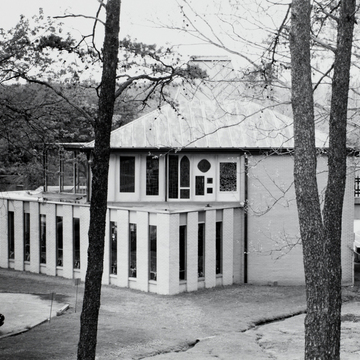Although this visitor center is not itself of major architectural interest, it is a mecca for stained glass aficionados. Englishman William John Blenko, Sr., who immigrated to America in 1893, set up shop in Milton in 1921 after several unsuccessful attempts to establish a factory elsewhere. Blenko's operation acquired a notable commission in 1927 when British architect Sir Giles Gilbert Scott selected it to fabricate glass for the windows of his Liverpool Cathedral. After Blenko died in 1934, his son, William H. Blenko, under whose aegis the company branched into production of decorative glassware and stemware, succeeded him as president.
In the 1950s the company was the first American firm to introduce and make dalle de verre, a product first called slab glass and now more commonly known as faceted glass. Molten glass, poured into a mold approximately an inch deep, is formed into slabs, known in the trade as dalles, which are then cut, faceted, and arranged in patterns with thick epoxy or concrete poured between them. Among Blenko's largest commissions for slab glass were the 24,384 dalles (in twenty-four colors and seventeen shapes) used in the windows of the U.S. Air Force Academy Chapel (Skidmore, Owings and Merrill, 1963) in Colorado.
The company continues to manufacture traditional stained glass as well, and its products have been used in windows at St. Patrick's Cathedral and the Cathedral of St. John the Divine in New York, the National Cathedral in Washington, D.C., and Rheims Cathedral in France, whose original windows were destroyed in World War II.
The visitor center includes an exhibit area, a salesroom, and an observation area connected to the plant, where visitors can watch glass being made. A “garden of glass” features glass sculpture and fences with inserts of colored glass. The two-story, sharply angled, modern structure is faced with yellow brick and topped with a copper-covered pyramidal roof. Expansive windows light the interior. Although the Charleston firm now known as ZMM was the architect of record, William H. Blenko's guiding hand in designing this showcase of the glassmaker's art is obvious. The firm, still owned and operated by the Blenko family, continues

